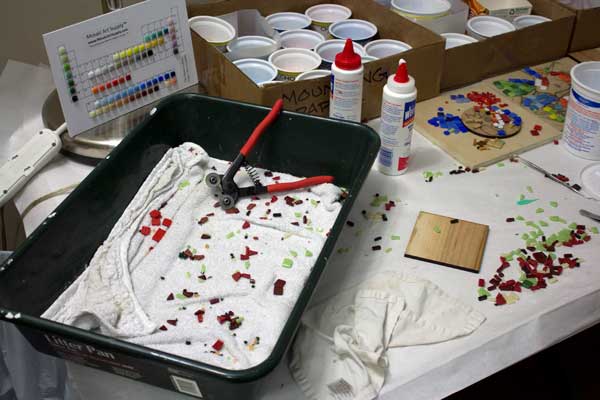Cutting glass tile with a mosaic glass cutter is a relatively quiet and gentle process because not much force is required to make the cut. However, glass is a brittle material, and cutting it with a compression tool causes pieces to snap off and bounce across the room. In addition to usable pieces of tile, tiny slivers of glass are also produced and traces of dust. While this waste isn’t produced in large quantities, it does need to be contained, especially when the work is being done at home, because the slivers are extremely sharp and dusts of all type should not be breathed (including generic materials like sand and sawdust).
Fortunately, the wastes from the cutting process can be contained easily using ordinary household items such as a shallow plastic tray or pan and a damp dish towel.

Glass Slivers and Old Towels
Pricked fingertips are a common injury, especially when you attempt to pick up a freshly cut piece of tile with a sharp triangular point instead of using a pair of tweezers as recommended. While virtually every injury I had of this type over a 15+ year period was superficial, it can be annoying especially if you work with mosaic on a daily basis like I do for long periods.
But pricked fingertips aren’t the real problem, at least in my experience. The most common form of injury experienced when working with glass mosaic are cuts from tiny glass slivers that lie hidden on work surfaces until you run your hand over them or rest your forearm. Fortunately, cuts from stray slivers can be completely avoided by common sense practices such as cutting over a pan lined with an old hand towel or dish towel and using a vacuum to periodically clean up the surrounding worksurface.
The dish towel at the bottom of the cutting pan helps prevent cuts when you pick up pieces of tile because the slivers resting on the soft terry cloth material of the towel don’t have a hard surface to push them into your skin.
Make sure you don’t reuse the old dish towel for other purposes because slivers can become tangled or embedded in the fabric. Also make sure don’t shake it out in a way that creates dust of flings slivers around. I prefer to rinse mine out in a basin of water. If I do have to shake out crumbs, I do it by holding the towel INSIDE a large trash can. I also mist the towel thoroughly beforehand to make sure the shaking doesn’t make dust fly.
Humidity and Dust
Dust can be controlled by humidity. While dry air allows tiny dust particles to become airborne more easily and stay in the air longer, moist air tends to make dust precipitate out of the air faster and helps keep dust stuck to surfaces. That is why factories often have misting sprinklers running in the ceilings, especially at times of the year when the AC or heat is running continuously.
You can do similarly by using a spray bottle to occasionally mist over your cutting area and keeping your dish towel moist inside your pan. The damp dish towel serves as a reservoir of moisture that keeps the air above it relatively humid. The humid air helps any trace amounts of dust created by cutting fall out of the air and onto the towel. The terry cloth fabric of the towel helps trap the dust once it settles.
Cutting Pans And Stray Pieces
While the safety issues mentioned above are usually ignored as a nuisance, the problem of having to chase down a loose piece every time one shoots across the worktable and onto the floor is a lot harder to ignore. Stray pieces of tile are sometimes sharp, and they can scratch floors or cut bare feet if walked on. A cutting pan made from a shallow litter box (purchased new) or plastic tote can help contain these useful pieces in addition to any waste that is created. I keep my mosaic and glue right beside my cutting pan so that I can transfer the cut pieces directly to the mosaic -without having to get up every few minutes to find strays!

Leave a Reply